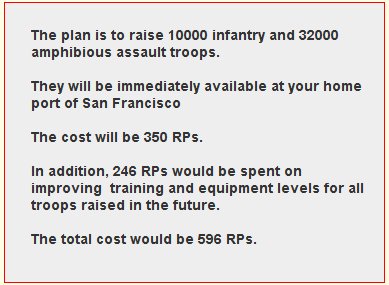
(The following assumes you have navigated to the Build Troops Screen. If you need help with how to do this, or what the screen is used for, see how to build troops.)
When the screen first appears, your 2IC has already developed a plan, the details of which are summarised in the grey text area at the top right of the screen:

The summary of the plan has some important elements, which are explained below.
The Plan sets a target number of infantry and amhibious assault troops to raise. The numbers depend on the total RPs that are allocated and also the balance of types you want - the ratio of normal infantry to amphibious troops.
You can adjust both the RPs you wish to spend (see changing the budget, as well as the ratio of troop types (see changing the troop ratio).
You can also set a limit on the total number of troops you wish to have relative to the estimated number of enemy troops. (See Changing the limit on troop numbers.
The summary tells you when the troops will be available.
On the first turn, these troops become immediately available, without the usual training time. (This is the same as with ships - where those 'built' on turn one appear immediately - unless their commissioning has been deferred for some reason).
On all subsequent turns, troops require time to be trained before they can become available for operational use.
The training time is a function of the complexity of the unit's training needs. This depends mainly on the level of training to be given (including any amphibious assault training) and the degree of mechanisation.
It can take 3 months or so to train a very basic infantry unit, and 3 or 4 times that (or more) if training requirements are set very high and the unit is also to be trained in amphibious assaults.
Training level
Each country starts a game with an historical training level for their troops. (Amphibious and non-amphibious training levels are recorded separately). For example, German troops have a very high level of training compared to say Italian troops. US amphibious troops (marines) are well trained - somewhat more so than the normal soldiery.
Through targeted expenditure, you can increase the training levels of all new troops you raise - see increasing training levels.
The cost (in RPs) of raising the troops is shown.
There is a separate cost shown also for any planned expenditure to develop training or improve equipment levels for new troops.
Each country starts with priorities for improving training and equipment, based on the starting levels. For example, the US, which starts with high equipment levels, has a lesser priority on improving them further than the Italians, who sorely need much better equipment.
You can separately change the priority allocated to developing training or equipment - see increasing equipment levels.
The plan shows, at the end of the summary, the total RP cost.
Use this information to help refine the plan. For example, if you want to reduce the cost, you can do so, without necessarily reducing troop numbers, by reducing expenditure on better training or equipment. Or you can scale everything down by reducing the budget expenditure for troops as a percentage of your overall budget.